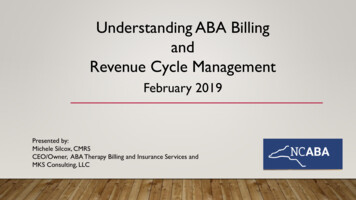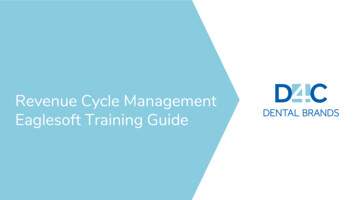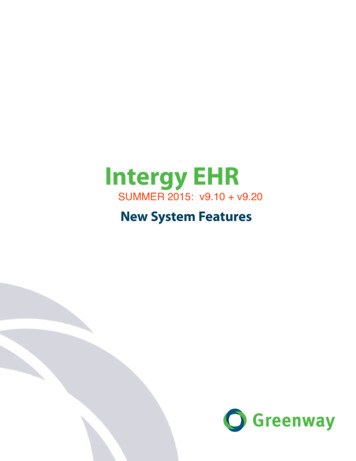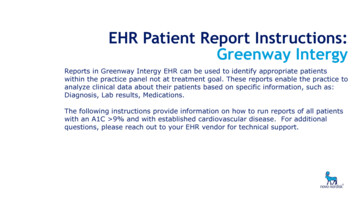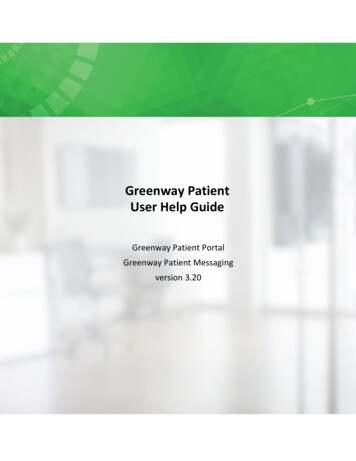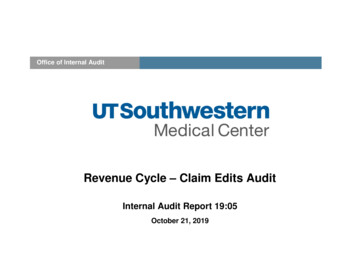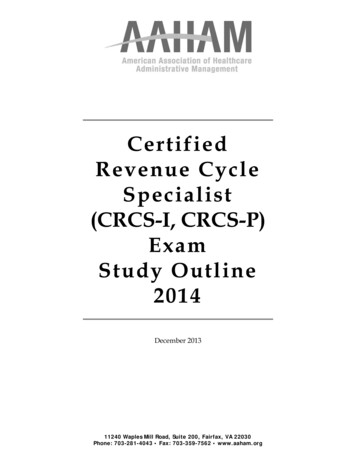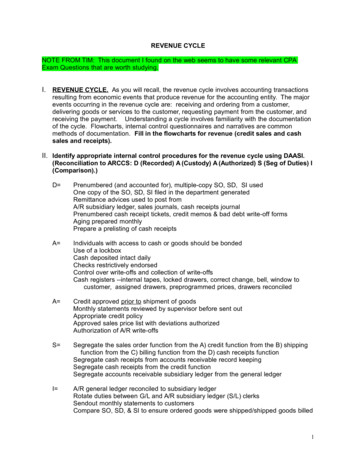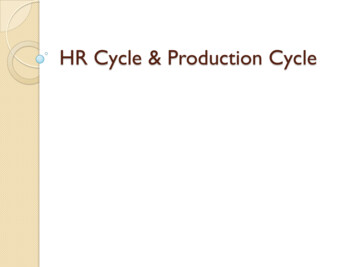
Transcription
REVENUE CYCLE MANAGEMENTREVENUECYCLEMANAGEMENTBest Practices Guide
TABLE OF CONTENTSIntroduction. 3What is RCM?. 4How does RCM differ from traditional billing?. 5How can a practice measure financial health?. 6Days in accounts receivable. 6Clean claims ratio. 7Net collections ratio. 8No longer just back office. 10Front office responsibility. 11Clinician responsibility. 11Integrated clearinghouse. 12Patient responsibility. 13Value-based payment models. 14What are value-based programs?. 15How are physicians paid under these programs?. 15How is quality measured?. 15How is cost measured?. 16Specific value-based programs. 16How will value-based models affect RCM?. 16Healthcare’s ICD-10 opportunity and challenge: Are you leaving money on the table?. 18The post-ICD-10 revenue challenge. 19Back office staff is spending more time checking codes, taking them away fromreworking claims. 19Increased denials caused by incorrect coding/lack of specificity. 19Increased documentation activities. 20RCM vendors. 22Considerations for using an RCM vendor. 23Does an RCM vendor make sense for your practice?. 23
REVENUE CYCLE MANAGEMENT
REVENUE CYCLE MANAGEMENT:FINANCIAL STABILITY FOR THE FUTURE OF HEALTHCAREIntroductionThe critical role of effective revenue cycle management (RCM) is unprecedentedin healthcare. As multiple regulatory initiatives converge with existing demandfor faster billing cycles and cost containment, provider organizations are facing aperfect storm of clinical and financial challenges.For many practices, the struggle to collect patient responsibility balances is aconcern extending throughout the practice. Beginning with front office knowledgegaps limiting a staff’s ability to collect monies owed and extending to a lack ofproactive management among back-office personnel to ensure payers and patientsfollow through with payment, practices are leaving valuable revenue on the table.Payment delays can be attributed to a host of issues, including inaccurate coding tothe more severe issue of rejected or denied claims that can negatively impact thebottom line.Often, ineffective approaches to RCM are the culprit. An August 2014 HealthcareFinance article revealed that “even some of the most prominent healthcaresystems experience significant losses, primarily within outpatient areas of service,”and “there can be a 20-25 percent loss in revenue in certain clinical departments.”Timely revenue cycle processes are critical to future success and positioning,especially in light of the rise of high-deductible health plans (HDHPs) and theincreasing number of patients responsible for their own healthcare costs. To betterposition for future reimbursement challenges, practices must embrace new RCMmodels and best practices to improve patient collections.The number of patients with HDHPs and health savings accounts has grown 15percent annually for several years and now stands at 15.5 million people. It’s atrend that is expected to continue, and practices that maintain the status quo interms of RCM will most likely see a decline in profitability.The purpose of this guide is to educate provider organizations about evolvingchallenges to RCM and teach best practices for improving revenue collections.Providers will learn how to effectively train staff and apply processes that promoterevenue collection and improve overall financial health. To better equip providerswith the tools needed to successfully navigate today’s reimbursement landscape,we will also introduce Greenway Revenue Services, an RCM partnership thattouches every practice function — from the front desk to the back office — to helpmanage revenue cycle from initial patient encounter to collection and beyond.Two icons will be used next to section takeaways, indicating the target for thatparticular bullet.“In the last six months, we’ve foundthey’ve really helped us with ourreimbursements,” said LorenaMaunez, billing administrator withSouth Bay OB-GYN. “We’ve increasedour revenue, and we’re excited to seewhat the future brings with RCM.”Optima Women’s Health attributesmuch of its success with RCMto Greenway Revenue Services’team-oriented approach.“I absolutely love having an RCMteam. That’s the keyword: team,” saidVandna Jerath, M.D., FACOG. “Witha team approach, different peoplehave different roles — you have anaccount manager; you have a personwho works on the collections; youhave a person who works on thecharges and the payment posting.Everybody is specialized in whatthey do.”Greenway Revenue Services knowsthe nuances of billing for differentspecialties such as OB-GYN, neurology, gastroenterology, cardiology, pediatrics, internal medicine,orthopedics and pulmonology. Theteams offer the tools and trainingpractices need to: Track claims data Ensure accurate and timelyclaims submission Boost collection ratesProvidersBilling ManagersFocus on capturing outpatient charges. Healthcare Finance News. August8, us-capturing-outpatient-charges2January 2013 Census Shows 15.5 Million People Covered by Health Savings Account/High-Deductible Health Plans. Washington D.C.America’s Health Insurance Plans. June 2013. http://www.ahip.org/HSA2013/3 Optimize billing practices
WHAT IS RCM?
WHAT IS RCM?In simple terms, RCM refers to the steps that healthcare organizationsmust take to receive payment for services rendered. Historically viewedas a straightforward back-office function, RCM now touches every aspectof a practice.A complete RCM strategy is comprised of three main functions:1) Generate revenue: Practice survival and sustainability depend onthe ability to generate revenue. By reducing gaps and inefficiencies inscheduling to maximize reimbursement, practices can achieve this goal,but it requires a proactive approach to both scheduling and capture of allnecessary patient information and copays up front. When this functionof revenue cycle is optimized, practices can increase their revenue byminimizing the number of no shows.Takeaways Practices should not make themistake of believing revenuecycle management only appliesto the back office. Front office,back office and clinical staff allplay an important role in bringingin revenue. Only 62 percent of practicesreview delinquent claims.2) C apture revenue: Once a patient is called from the waiting room,the clinical encounter begins and extends through the time a patientleaves the appointment. The activity that occurs during this timeframeis foundational to a practice’s ability to capture revenue and must bethoroughly recorded. Accurate and complete documentation of servicesrendered and proper coding of those services is required to receivepayment at the highest level.3) Collect revenue: In general terms, back office billing functions enablea practice to collect revenue and round out the RCM cycle. Included inthis category are the steps associated with billing, posting and collectionof payments and should be viewed by practices as the last step of theRCM process.How does RCM differ from traditional billing?Within traditional fee-for-service care delivery models, billing wascharacterized by the tasks and functions performed in the back office and wasnot often viewed as a shared responsibility between front office, back office andclinical staff. Today, billing strategies must evolve and mature within providerorganizations to reflect clinically driven RCM models that proactively addresspayment even before a patient enters the office door.For example, clinically driven RCM would involve conducting eligibility checkingbefore a patient arrives in the office. But it’s not just about financial aspects.Clinically driven RCM takes an overall proactive approach to patient health,including reaching out to patients to remind them when it’s time for check-ups,services and procedures that may be required to maintain control over chronicconditions, such as diabetes and high blood pressure.What is RCM? 5
As healthcare’s lean, quality-driven healthcare climatecontinues to unfold, revenue cycle depends on the completeand accurate documentation of patient information,beginning at the point of registration and extending throughthe clinical documentation process. One single gap in datacan significantly impact revenue streams.For instance, if the front office staff is unable to get allthe patient information required for payment or failsto check for eligibility, the downstream impact can besignificant billing delays or irreversible claim denials. Lackof proactive outreach up front can also lead to workflowinefficiencies as back-office staff members are forced tospend valuable time correcting front office errors ratherthan engaging in timely follow up with payers.The reality is that only a fraction of problematic claims areever resolved. Greenway Health research finds that only62 percent of practices review delinquent claims and only59 percent of secondary claims are filed due to back-officetime constraints.Often, RCM practices that hinder optimal billingperformance can be traced back to four common mistakesin practices:1) Not focusing on process: Billing glitches canoriginate in many areas of practice operations,especially during times of peak scheduling. Whenmany patients are coming in and out of the doors ofa provider organization, key patient information maybe miscommunicated, overlooked or even lost. Billingprocesses must be standardized and optimized as a“cycle” that is clinically driven and embraced by all staff.2) N eglecting critical information: There are a lotof documents that move through a practice. Whilemanaging all the critical information contained inthese documents may seem overwhelming, it is atask that providers must embrace to optimize revenueopportunities. For instance, when organizationsunderstand the nuances of payer contracts, they arein a better position to fully leverage payment andnegotiations. Equally important is staying on top ofedit reports, explanation of benefits forms and otherclaims issues, and making sure denied claims arereworked and resubmitted as needed.3) Failing to follow up: Many strategies are employedby provider organizations to improve collections,including appeals, tracers, collections letters andpayment plans. While these tactics are a good firststep, many fall short of success due to lack of followup. Often, by the time a practice realizes a patient hasnot responded, it’s too late to collect the money owed.4) D rowning in details: Details are important, but whenbilling practices become all about miniscule issues,organizations can neglect the bigger-picture revenueopportunities. For example, if practices look fortrends, such as repeated claims denials for the sameservices or claims that are denied for registrationerrors, processes can be reworked to eliminate thepotential for those errors to occur in the future.How can a practice measurefinancial health?Before an effective, clinically driven RCM strategy canbe implemented, an understanding of current financialhealth must exist. Practices can leverage a number of bestpractice metrics to make this determination.DAYS IN ACCOUNTS RECEIVABLEA four-provider family practice started with 104 days inAR in April when they first adopted Greenway RevenueServices. By September, it was down to 63 days, animprovement tied to the expert claims scrubbing providedby Greenway’s RCM teams and proactive follow-ups withpayers on outstanding claims to ensure practices are paidas quickly as possible.The days in accounts receivable (AR) measurementrepresents the length of time it takes on average f
the nuances of billing for different specialties such as OB-GYN, neu-rology, gastroenterology, cardiol-ogy, pediatrics, internal medicine, orthopedics and pulmonology. The teams offer the tools and training practices need to: Track claims data Ensure accurate and timely claims submission Boost collection rates Optimize billing .
